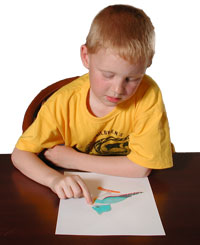
|
|
Training Effective Use of Vision
Awareness and Attention to Detail
Patterns, Letters, Numbers and Words
Activities to Encourage the Use of Vision
Discrimination of details in pictures
Matching pictures of objects by size. Use objects that are the same type but different size. Match the ones that are the same size or all the small ones or all the big ones. Pictures used could be clothes, fruit or bowls.
Matching pictures by shape. Use simple shapes such as squares and circles at first. Match solid shapes with solid shapes, that is pick out all the squares. Then match solid shapes to outline shapes. During the matching activity the person can trace around the outline of the shape with a finger.
The next step is to match solid pictures to outline pictures such as a hand, stool or fruit.
Matching outline shapes or pictures. From a page of shapes the person can point to all the same shapes or he can colour in all the shapes that are the same.
Imitation of actions in pictures. The pictures have to be identified and the actions copied. Start with simple actions such as sitting, lying or standing. More difficult actions to see in pictures could be looking at a book, pouring water into a mug or mixing food in a bowl. The next step is to copy expressions from pictures such as laughing or crying or pretending to be asleep.
Matching pictures with different detail. Use pictures of the same objects that have different patterns on them. Examples are pictures of shirts, baskets or balls.
Use pictures with people and objects showing a scene. The person has to identify what is in the picture. For example find all the people, what they are doing and name the objects. Pictures should be of familiar activities such as a family eating, people in a schoolroom, a market, children playing or people working.
Finding and naming parts of objects or people in complicated pictures. Examples are - people's arms or heads, handles on a basket or food being cooked.
Pictures with missing parts. The person has to tell or show the necessary part that is missing in a picture. Examples are people or animals with a leg missing or a bird without a beak or wings.
Showing missing parts of shapes. The person has to draw in or point to the missing part such as a square with only three sides.
Finding partly hidden objects in pictures. An object which is behind another object has to be found in a picture. An example would be an animal partly hidden behind a bush or tree.
Arranging pictures of events in the order that they happen. Start with a simple activity in 2 pictures such as picking a piece of fruit and then eating it. Talk about what happens in each picture and which comes first. Use more complex activities with 3 or more pictures.
Identifying pictures of objects that belong together. Pictures of objects can be grouped together because of what they all look like or what they do. Pictures of animals - the groups could be animals that swim, fly or walk; pictures of objects - the groups could be the kinds of objects they are such as clothing or food.
Put the following activities into the order you would use in training
- using pictures for training
- finding partly hidden objects in pictures
- matching simple shapes (squares and circles)
- sorting pictures into groups
- using real objects for training
- imitating actions in pictures
|
|

